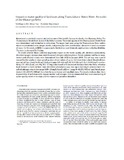Impact on water quality of land uses along Thamalakane-Boteti River: an outlet of the Okavango Delta
Date
2008-07-08Author
Masamba, W.R.L.
Mazvimavi, D.
Publisher
ElsevierType
Published ArticleMetadata
Show full item recordAbstract
Botswana is a semiarid
country and yet has one of the world’s famous wetlands:
the Okavango Delta. The Thamalakane-
Boteti River is one of the Delta’s outlets. The water quality of the Thamalakane-Boteti
River was determined
and related to its utilisation. The major land uses along the Thamalakane
River within Maun are residential
areas, lodges, hotels, and grazing
by cattle and donkeys.
The water is used as a source of water for livestock,
wildlife in a game park, horticulture
and domestic
applications
including drinking.
The river is also used for fishing.
To check whether these activities
negatively impact on the water quality, pH, electrical
conductivity,
dissolved oxygen,
temperature, total dissolved nitrogen
and phosphorus,
Faecal coliforms
and Faecal
streptococci and selected metals
were determined
from July 2005 to January 2006. The pH was near neutral
except for the southern most sampling sites where values
of up to 10.3 were determined. Dissolved oxygen
varied from 2 mg/l to 8 mg/l. Sodium (range 0.6–3.2 mg/l), K (0.3–3.6 mg/l), Fe (1.6–6.9 mg/l) conductivity
(56–430 lS/cm) and Mg (0.2–6.7 mg/l) increased with increased distance
from the Delta, whereas lead showed a slight decline. Total dissolved
phosphorus was low (up to 0.02 mg/l) whereas total dissolved
nitrogen was in the range 0.08–1.5 mg/l. Faecal coliform (range 0–48 CFU/100 ml) and Faecal streptococci
(40–260 CFU/100 ml) were low for open waters with multiple uses. The results indicate
that there
is possibility
of pollution with organic matter and nitrogen. It is recommended that more monitoring of
water quality needs to be done and the sources of pollution
identified.
Collections
- Research articles (ORI) [270]

